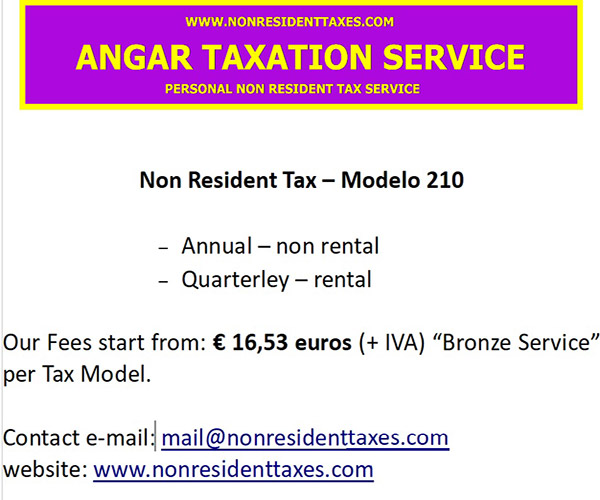Join Talk Quesada


 Welcome to Talk Quesada! My name's Alex and this is my website all about Ciudad Quesada in Spain. Talk Quesada is free to sign up and use so register below!
Welcome to Talk Quesada! My name's Alex and this is my website all about Ciudad Quesada in Spain. Talk Quesada is free to sign up and use so register below!
Community law/horizontal property act
Community law/horizontal property act
![]() by elchedave » Thu Aug 29, 2019 8:08 pm
by elchedave » Thu Aug 29, 2019 8:08 pm
Hi all,
Could anyone help with this?? If a person owns more than one property within a community, at the AGM/EGM would they be allowed one vote per property owned or just one vote per se.
Thanks in advance,
Dave
Could anyone help with this?? If a person owns more than one property within a community, at the AGM/EGM would they be allowed one vote per property owned or just one vote per se.
Thanks in advance,
Dave
- elchedave
- Posts: 1450
- Joined: Sat Oct 22, 2016 10:31 am
- Which part of Spain are you from?: Guardamar
- Gender: Male
Re: Community law/horizontal property act
![]() by polop » Thu Aug 29, 2019 8:56 pm
by polop » Thu Aug 29, 2019 8:56 pm
elchedave wrote:Hi all,
Could anyone help with this?? If a person owns more than one property within a community, at the AGM/EGM would they be allowed one vote per property owned or just one vote per se.
Thanks in advance,
Dave
Nearly certain 2 votes on our community we have one owner with 3 properties and when we vote he has multiple votes.
-

polop - Posts: 968
- Joined: Wed Mar 15, 2017 3:21 pm
- Which part of Spain are you from?: La finca
- Gender: Male
Re: Community law/horizontal property act
![]() by Bee » Thu Aug 29, 2019 9:01 pm
by Bee » Thu Aug 29, 2019 9:01 pm
Surely one vote per property. You have to pay community charges on each property so each property is seen as a different entity. When voting is being counted on changes to rules etc at AGM it is weighted on the sq metrage of your property same as how your community charge is levied on the size of your property.
Bee
Bee
- Bee
- Posts: 3311
- Joined: Sun Dec 10, 2017 1:07 am
- Which part of Spain are you from?: Torrevieja
- Gender: Female
Re: Community law/horizontal property act
![]() by Beesknees » Thu Aug 29, 2019 9:20 pm
by Beesknees » Thu Aug 29, 2019 9:20 pm
Transcript from HPL under Section 3 Number 4 explains Allocation of units and Obligation of owners
Section 3 Units and common parts
In the ownership system set forth in section 396 of the Civil Code, each flat or premises owner shall have:
(a) The absolute ownership right over an space sufficiently delimited, intended for independent use and enjoyment, along with the architectural elements and facilities of any kind, whether apparent or not, included within its boundaries and for the exclusive service of the owner, as well as any appurtenances specifically laid down in the commonhold community statement, including those located outside the delimited space.
(b) Joint ownership, in conjunction with the other owners of flats and premises, of the remaining common parts, belongings and shared facilities.
A percentage of the commonhold shall be allocated to every flat or premises in relation to the value of the building and expressed as a percentage of it. Said allocation shall serve as a basis to determine participation in the expenses and benefits of the commonhold. Improvements or impairments of each flat or premises shall not affect the commonhold allocation, which may be altered only in accordance with the provisions of sections 10 and 17 of this Act.
Each owner can make free use of his ownership right, but he may not separate the elements composing it and the transfer of the right of use shall not affect the obligations arising out of this property regime.
3.1 Key features
Commonhold is a type of property ownership in which an owner owns:
i. a freehold in a unit.
ii. a common hold on the common parts which are jointly owned by all the commonholders.
Therefore, commonhold land consists of areas owned separately and areas where there is a shared interest.
The commonhold’s title should identify whether an area is part of a unit or part of a common element but if nothing is specified about a concrete area it will be considered as a common part . SC ruling 11-10-1967, 13-03-1981, CA ruling in Alicante 15-12-2000, CA ruling in Cadiz 28-04-2006
It is important to know precisely what is and is not included within the definition of a unit for purposes of maintenance.
For example, if the commonhold has the obligation to maintain the common area, and the unit-owner has to maintain their separate area (freehold), it is crucial to determine whether things like awnings, heating ducts, electrical outlets, floors, windows, etc are part of the separate area or part of the common area.
The Act provides default provisions that apply when these issues are not adequately addressed in the title. There are least two and sometimes three, property interests in a commonhold:
1) There is an interest in freehold called ‘unit’
2) There is also an interest in the commonhold association that owns the common area
3) There may also be an interest called ‘exclusive use common area’ or ‘limited common elements’.
These are portions of the common area that are for the use of a particular unit.
They are usually patios attached to first floors or, roof terraces and balconies allocated in the title for the exclusive use of one or more but fewer than all the units. Exclusive common areas are technically ‘owned’ by the commonhold.
The unit owner, however, may have the obligation to maintain his or her ‘exclusive use common area’. The Act requires all exclusive use common areas to be identified in the title.
3.2 Unit
It is the owner’s freehold interest defined in section 396 of the Civil Code. ‘The various flats or premises of a building or parts of them that can be subject to independent use by virtue of an entrance from either the public thoroughfare or a common area might be the object of separate ownership.’
This will typically consist of a flat in a block of flats; a house on a housing estate which shares communal facilities with other house in the estate; a unit on an industrial estate or a retail shop in a parade; or any combination of such features. There is no rule that a commonhold must only relate to residential property.
It may be a purely commercial development, residential or a mixture.
A unit comprises the cubic air space contained within the inner surface of the boundary walls, the under surface of the ceiling and the upper surface of the floor. Section 396 of the Civil Code defines the commonhold unit and the common parts.
The concept of unit requires ‘independent use by virtue of an entrance from either the public thoroughfare or a common area.’
3.3 Common parts
Common parts all those necessary for the use and enjoyment’ are every part of the building that is not contained in a unit. The definition is therefore a negative one.
The freehold of the common parts is owned by the commonhold association. In practice, all access ways used in common by commonholders, such as halls, stairways, lifts, pathways and even roads , will be part of the common parts. Communal facilities such as gardens, play areas, rubbish storage areas, swimming pools, tennis courts and so forth, will be common parts.
Section 396 of the Civil Code lists common parts although it is not a closed list under the terms of the end of that section .‘and any other material or juridical elements that for its nature or destiny turn out to be indivisible’
• Floor: The gardens and the subsoil of the units is included
• Airspace above a unit.
• Foundations: Including pillars, beams, floor structure and bearing walls.
• Roofs: Unless otherwise were indicated in the title.
• External elements like facades, with the external coatings of terraces, balconies and windows, including their image or configuration.
• Shutter elements and their exterior coatings. • Entrance elements: Doorways, the stairs, porter’s lodge, corridors, ways.
• Facilities: Elevators, warehouses, meters, telephones.
• Ducts and drainages: It should liable the commonhold for repairs and maintenance of this elements up to the unit.
• Easements
3.3.1 Addition or removal of common parts to and from the commonhold
It should be distinguished between conversions of a private area to a common one and on the other hand transformation from common area to private.
In the latter the commonhold shall be entitled to sell the new private part after its conversion. In both cases unanimous consent is required because it would be necessary to amend the title.
3.4 Appurtenances
See section 5.
4. Commonhold allocations
The percentage each unit has to contribute as its share of the overall costs of the commonhold which will also be used to set out the allocation of votes. These percentages allocated to the units must total 100.
The Commonhold Community Statement must allocate to each unit a fraction or percentage in order to contribute to the common expenses of the commonhold. Thus, every present and prospective owner is aware of the relative contributions.
These allocations are fundamental to the running of the commonhold and special provisions apply to their amendments. However, the allocation of a percentage to each unit to the contribution expenses may not be the same as the percentage of the whole commonhold which belongs to each owner. Therefore, it must be distinguished between the quota construed as a share on the value of the common parts and the quota for the contribution expenses; both could and could not coincide.
It is clear that section 9 (1) (e), which establishes an obligation for any commonholder ´to contribute, according to the commonhold allocation specified in the commonhold community statement or to what may have been specially established’- permits criteria other than the general allocation established in the title in order to calculate the contribution expenses. Commonholds rarely make profits, nevertheless in the event of letting common parts of roofs for telephone masts or adverts (for instance) earnings must be distributed according to the quota established in the title.
5. Restrictions on the ownership derived from the commonhold land’s nature
The Act enshrines the principle of free alienability which means that a commonhold unit will be transferred in the same way as the transfer of any other freehold property. Just as it is not possible to restrict the transfer of the freehold estate in land, nor may the transfer of the freehold estate in a unit in commonhold land be restricted.
Similarly, the title or the Articles may not prevent or restrict the creation, grant or transfer by a commonholder of an interest in his unit or restrict in any way a charge over the unit.
Even though a commonhold unit is part of the freehold estate in commonhold land and is a defined freehold section of that commonhold, there are some rules and restrictions arising from the nature of commonhold land which are not applicable to standard freehold.
The last paragraph of this section contains the paradigmatic restriction on commonhold land; the transfer of a commonhold unit means the transfer of the share in the common elements inseparably.
Finally, if the unit-holder wishes to transfer the right of use of his property, for instance renting his or her unit, to another individual that would not imply any change in the application of the Act.
6. Tenants rights
The Act does not include any provision for tenants of unit-holders to be involved in commonhold duties; however they are bound, in terms of co-existence, by the conditions of the title and the Articles.
Tenants will not be members of the Owners´ Committee. However, it is not possible to ban the tenant’s use of the common parts.
Tenants cannot apply for new facilities as may the commonholders. CA in Asturias 12-07-2002 ‘tenants cannot apply for the removal of a telephone mast in the roof’
Section 3 Units and common parts
In the ownership system set forth in section 396 of the Civil Code, each flat or premises owner shall have:
(a) The absolute ownership right over an space sufficiently delimited, intended for independent use and enjoyment, along with the architectural elements and facilities of any kind, whether apparent or not, included within its boundaries and for the exclusive service of the owner, as well as any appurtenances specifically laid down in the commonhold community statement, including those located outside the delimited space.
(b) Joint ownership, in conjunction with the other owners of flats and premises, of the remaining common parts, belongings and shared facilities.
A percentage of the commonhold shall be allocated to every flat or premises in relation to the value of the building and expressed as a percentage of it. Said allocation shall serve as a basis to determine participation in the expenses and benefits of the commonhold. Improvements or impairments of each flat or premises shall not affect the commonhold allocation, which may be altered only in accordance with the provisions of sections 10 and 17 of this Act.
Each owner can make free use of his ownership right, but he may not separate the elements composing it and the transfer of the right of use shall not affect the obligations arising out of this property regime.
3.1 Key features
Commonhold is a type of property ownership in which an owner owns:
i. a freehold in a unit.
ii. a common hold on the common parts which are jointly owned by all the commonholders.
Therefore, commonhold land consists of areas owned separately and areas where there is a shared interest.
The commonhold’s title should identify whether an area is part of a unit or part of a common element but if nothing is specified about a concrete area it will be considered as a common part . SC ruling 11-10-1967, 13-03-1981, CA ruling in Alicante 15-12-2000, CA ruling in Cadiz 28-04-2006
It is important to know precisely what is and is not included within the definition of a unit for purposes of maintenance.
For example, if the commonhold has the obligation to maintain the common area, and the unit-owner has to maintain their separate area (freehold), it is crucial to determine whether things like awnings, heating ducts, electrical outlets, floors, windows, etc are part of the separate area or part of the common area.
The Act provides default provisions that apply when these issues are not adequately addressed in the title. There are least two and sometimes three, property interests in a commonhold:
1) There is an interest in freehold called ‘unit’
2) There is also an interest in the commonhold association that owns the common area
3) There may also be an interest called ‘exclusive use common area’ or ‘limited common elements’.
These are portions of the common area that are for the use of a particular unit.
They are usually patios attached to first floors or, roof terraces and balconies allocated in the title for the exclusive use of one or more but fewer than all the units. Exclusive common areas are technically ‘owned’ by the commonhold.
The unit owner, however, may have the obligation to maintain his or her ‘exclusive use common area’. The Act requires all exclusive use common areas to be identified in the title.
3.2 Unit
It is the owner’s freehold interest defined in section 396 of the Civil Code. ‘The various flats or premises of a building or parts of them that can be subject to independent use by virtue of an entrance from either the public thoroughfare or a common area might be the object of separate ownership.’
This will typically consist of a flat in a block of flats; a house on a housing estate which shares communal facilities with other house in the estate; a unit on an industrial estate or a retail shop in a parade; or any combination of such features. There is no rule that a commonhold must only relate to residential property.
It may be a purely commercial development, residential or a mixture.
A unit comprises the cubic air space contained within the inner surface of the boundary walls, the under surface of the ceiling and the upper surface of the floor. Section 396 of the Civil Code defines the commonhold unit and the common parts.
The concept of unit requires ‘independent use by virtue of an entrance from either the public thoroughfare or a common area.’
3.3 Common parts
Common parts all those necessary for the use and enjoyment’ are every part of the building that is not contained in a unit. The definition is therefore a negative one.
The freehold of the common parts is owned by the commonhold association. In practice, all access ways used in common by commonholders, such as halls, stairways, lifts, pathways and even roads , will be part of the common parts. Communal facilities such as gardens, play areas, rubbish storage areas, swimming pools, tennis courts and so forth, will be common parts.
Section 396 of the Civil Code lists common parts although it is not a closed list under the terms of the end of that section .‘and any other material or juridical elements that for its nature or destiny turn out to be indivisible’
• Floor: The gardens and the subsoil of the units is included
• Airspace above a unit.
• Foundations: Including pillars, beams, floor structure and bearing walls.
• Roofs: Unless otherwise were indicated in the title.
• External elements like facades, with the external coatings of terraces, balconies and windows, including their image or configuration.
• Shutter elements and their exterior coatings. • Entrance elements: Doorways, the stairs, porter’s lodge, corridors, ways.
• Facilities: Elevators, warehouses, meters, telephones.
• Ducts and drainages: It should liable the commonhold for repairs and maintenance of this elements up to the unit.
• Easements
3.3.1 Addition or removal of common parts to and from the commonhold
It should be distinguished between conversions of a private area to a common one and on the other hand transformation from common area to private.
In the latter the commonhold shall be entitled to sell the new private part after its conversion. In both cases unanimous consent is required because it would be necessary to amend the title.
3.4 Appurtenances
See section 5.
4. Commonhold allocations
The percentage each unit has to contribute as its share of the overall costs of the commonhold which will also be used to set out the allocation of votes. These percentages allocated to the units must total 100.
The Commonhold Community Statement must allocate to each unit a fraction or percentage in order to contribute to the common expenses of the commonhold. Thus, every present and prospective owner is aware of the relative contributions.
These allocations are fundamental to the running of the commonhold and special provisions apply to their amendments. However, the allocation of a percentage to each unit to the contribution expenses may not be the same as the percentage of the whole commonhold which belongs to each owner. Therefore, it must be distinguished between the quota construed as a share on the value of the common parts and the quota for the contribution expenses; both could and could not coincide.
It is clear that section 9 (1) (e), which establishes an obligation for any commonholder ´to contribute, according to the commonhold allocation specified in the commonhold community statement or to what may have been specially established’- permits criteria other than the general allocation established in the title in order to calculate the contribution expenses. Commonholds rarely make profits, nevertheless in the event of letting common parts of roofs for telephone masts or adverts (for instance) earnings must be distributed according to the quota established in the title.
5. Restrictions on the ownership derived from the commonhold land’s nature
The Act enshrines the principle of free alienability which means that a commonhold unit will be transferred in the same way as the transfer of any other freehold property. Just as it is not possible to restrict the transfer of the freehold estate in land, nor may the transfer of the freehold estate in a unit in commonhold land be restricted.
Similarly, the title or the Articles may not prevent or restrict the creation, grant or transfer by a commonholder of an interest in his unit or restrict in any way a charge over the unit.
Even though a commonhold unit is part of the freehold estate in commonhold land and is a defined freehold section of that commonhold, there are some rules and restrictions arising from the nature of commonhold land which are not applicable to standard freehold.
The last paragraph of this section contains the paradigmatic restriction on commonhold land; the transfer of a commonhold unit means the transfer of the share in the common elements inseparably.
Finally, if the unit-holder wishes to transfer the right of use of his property, for instance renting his or her unit, to another individual that would not imply any change in the application of the Act.
6. Tenants rights
The Act does not include any provision for tenants of unit-holders to be involved in commonhold duties; however they are bound, in terms of co-existence, by the conditions of the title and the Articles.
Tenants will not be members of the Owners´ Committee. However, it is not possible to ban the tenant’s use of the common parts.
Tenants cannot apply for new facilities as may the commonholders. CA in Asturias 12-07-2002 ‘tenants cannot apply for the removal of a telephone mast in the roof’
- Beesknees
- Posts: 356
- Joined: Fri Aug 19, 2016 2:55 pm
- Which part of Spain are you from?: Lo Crispin
- Gender: Male
Re: Community law/horizontal property act
![]() by sunworshipper » Thu Aug 29, 2019 10:06 pm
by sunworshipper » Thu Aug 29, 2019 10:06 pm
We own 2 properties on our communty and we have one vote per property.
Happy in the sun.
-

sunworshipper - Posts: 1464
- Joined: Tue Nov 04, 2014 9:05 pm
- Location: Quesada
- Which part of Spain are you from?: Quesada
- Gender: Female
Re: Community law/horizontal property act
![]() by JillP » Mon Sep 02, 2019 1:22 pm
by JillP » Mon Sep 02, 2019 1:22 pm
We have 2 properties in our community, and we get 2 votes at the AGM.
Hope this helps.
Hope this helps.
- JillP
- Posts: 41
- Joined: Mon Mar 28, 2016 8:04 am
- Which part of Spain are you from?: Quesada
- Gender: Female
Re: Community law/horizontal property act
![]() by elchedave » Mon Sep 02, 2019 1:48 pm
by elchedave » Mon Sep 02, 2019 1:48 pm
Hi all,
many thanks for your replies, we now have a way forward.
Regards,
Dave.
many thanks for your replies, we now have a way forward.
Regards,
Dave.
- elchedave
- Posts: 1450
- Joined: Sat Oct 22, 2016 10:31 am
- Which part of Spain are you from?: Guardamar
- Gender: Male
Re: Community law/horizontal property act
![]() by TerryG » Mon Sep 02, 2019 2:40 pm
by TerryG » Mon Sep 02, 2019 2:40 pm
Some short and concise replies. 
- TerryG
- Posts: 339
- Joined: Sat Oct 08, 2016 6:40 am
- Gender: Male
8 posts
• Page 1 of 1
Related topics
-
- Similar Topics
- Replies
- Views
- Last post
-
-
Horizontal Law (debtors)
1, 2 by sunworshipper » Sat Apr 29, 2023 12:40 pm in Quesada general discussion - 13
- 725
-
by telmel

Sat Feb 10, 2024 2:29 pm
-
Horizontal Law (debtors)
-
-
Community charge.
1, 2 by dr.doolittle » Thu Mar 14, 2024 10:22 am in Quesada general discussion - 15
- 770
-
by Gustav

Sat Mar 16, 2024 5:32 pm
-
Community charge.
-
-
Community water meter box
by partygoer » Fri Jan 26, 2024 6:21 pm in Quesada general discussion - 1
- 153
-
by Chrisdee

Fri Jan 26, 2024 7:21 pm
-
Community water meter box
-
-
Community of Owners Problems
by Clara » Mon Feb 19, 2024 10:53 am in Quesada general discussion - 7
- 693
-
by Joyce

Wed Feb 21, 2024 11:25 am
-
Community of Owners Problems
-
-
Spanish grants for Community eco developments
by HPR » Fri Oct 06, 2023 4:26 pm in Quesada general discussion - 1
- 229
-
by partygoer

Sun Oct 08, 2023 12:22 pm
-
Spanish grants for Community eco developments
Return to Quesada general discussion
Who is online
Users browsing this forum: Brian Hunter, Google Adsense [Bot], Michael@sue and 43 guests
Login
Find in Quesada
Quesada pages
Quesada discussion
 Quesada general discussion
Quesada general discussion Banking and finances
Banking and finances Broadband, Wifi, Phone and TV
Broadband, Wifi, Phone and TV Buses and public transport in and around Quesada
Buses and public transport in and around Quesada Driving to Spain / Car hire in Spain / Buying and owning a car in Spain
Driving to Spain / Car hire in Spain / Buying and owning a car in Spain Fiestas in Quesada
Fiestas in Quesada Flights, baggage and airports
Flights, baggage and airports Health services in Quesada
Health services in Quesada Insurances and wills in Spain
Insurances and wills in Spain Items for sale and wanted in and around Quesada
Items for sale and wanted in and around Quesada Interesting articles about Spain
Interesting articles about Spain Jobs and careers in Quesada
Jobs and careers in Quesada Lost and found in Quesada
Lost and found in Quesada Market days
Market days Places to go for free Wi-Fi
Places to go for free Wi-Fi Recommended restaurants / cafes / bars
Recommended restaurants / cafes / bars Recommended Tradesmen and Companies
Recommended Tradesmen and Companies Residency in Spain: padron, residencia and passport advice
Residency in Spain: padron, residencia and passport advice Safety / security information and property in Spain hints and tips
Safety / security information and property in Spain hints and tips Taxes in Spain: Suma, NIE and general tax advice
Taxes in Spain: Suma, NIE and general tax advice Taxis in Quesada
Taxis in Quesada Things to do and places to go in and around Quesada
Things to do and places to go in and around Quesada Utilities in Spain: Electric, gas and water recommendations and advice
Utilities in Spain: Electric, gas and water recommendations and advice Weather in Quesada
Weather in Quesada Where to buy things in and around Quesada
Where to buy things in and around Quesada Where to hire things in and around Quesada
Where to hire things in and around Quesada
Properties discussion
Businesses and places in Quesada
 Bars and pubs in Quesada
Bars and pubs in Quesada Beaches near Quesada
Beaches near Quesada Beauticians / Beauty salons in Quesada
Beauticians / Beauty salons in Quesada Bedding and soft furnishings shops in Quesada
Bedding and soft furnishings shops in Quesada Butchers in Quesada
Butchers in Quesada Car dealers in Quesada: new and used car dealers
Car dealers in Quesada: new and used car dealers Car garages, mechanics, tyre fitter centres in Quesada
Car garages, mechanics, tyre fitter centres in Quesada Car hire in Quesada
Car hire in Quesada DIY / Bricolage / Ferreteria stores in Quesada
DIY / Bricolage / Ferreteria stores in Quesada Equipment hire centers in Quesada
Equipment hire centers in Quesada Estate agents in Quesada
Estate agents in Quesada Furniture shops in Quesada
Furniture shops in Quesada Garden centres and garden furniture shops in Quesada
Garden centres and garden furniture shops in Quesada Golf Courses in Quesada
Golf Courses in Quesada Grills / gates / metal items shops in Quesada
Grills / gates / metal items shops in Quesada Hairdressers in Quesada
Hairdressers in Quesada Hotels, guest houses and bed and breakfasts in Quesada and nearby
Hotels, guest houses and bed and breakfasts in Quesada and nearby Internet service providers that cover Quesada
Internet service providers that cover Quesada Launderettes / dry cleaners in Quesada
Launderettes / dry cleaners in Quesada Markets in Quesada
Markets in Quesada Medical / Health centers in Quesada
Medical / Health centers in Quesada Pet shops in Quesada
Pet shops in Quesada Pharmacies / Chemist shops in Quesada
Pharmacies / Chemist shops in Quesada Restaurants in Quesada
Restaurants in Quesada Shopping centres in Quesada
Shopping centres in Quesada Sports centres and gyms in Quesada
Sports centres and gyms in Quesada Supermarkets in Quesada
Supermarkets in Quesada Swimming pool services in Quesada
Swimming pool services in Quesada Town Halls (Ayuntamientos) in Quesada
Town Halls (Ayuntamientos) in Quesada Waterparks/Aquaparks in Quesada
Waterparks/Aquaparks in Quesada
- TalkQuesada » Board index
- The team • Delete all board cookies • All times are UTC [ DST ]
- Our other websites:
- Costa Blanca forum
- Costa Calida forum
- Costa del Sol forum
- Costa de Almeria forum
- Costa de la Luz forum
- Costa Dorada forum
- Costa Brava forum
- UK forum
- Jobs in the UK
- Our policies:
- Privacy policy
- User agreement
- Content policy
- Website created and operated by JSM Forum Websites
























 Weather in Quesada
Weather in Quesada Webcams in Quesada
Webcams in Quesada